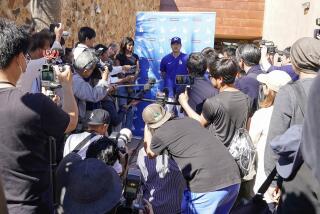Crown Princess Begins New Life Amid a Shower of Congratulations : Japan: Fireworks, a parade and media celebrities combine with a break in the weather to welcome the newlyweds.
- Share via
TOKYO — Masako Owada, the former hard-driving, American-educated career diplomat, began the first day of a new life Wednesday as Japan’s Crown Princess Masako in a sparkling tiara and glittering gown, while an enraptured nation set off fireworks, composed love songs and showered congratulations on her marriage to Crown Prince Naruhito.
Reflecting how Japan straddles East and West, ancient and modern, the royal wedding ceremonies abruptly shifted from antique court costumes and mystical Shinto rites in the morning to a jubilant parade in a Rolls-Royce convertible in the afternoon.
Naruhito, 33, wore black tails and Masako, 29, showed off her formal ivory gown threaded with gold, created by top designer Hanae Mori.
The morning’s wedding rite in the sanctuary of the sun goddess, a wood-and-paper shrine standing amid camphor trees and black pines on the Imperial Palace grounds, was stern and solemn. The royal pair, wrapped in heavy traditional dress, shuffled forward stiffly with no facial expressions.
But all that gave way to happy smiles and visibly relaxed miens as the newlyweds chatted together and waved to 190,000 well-wishers along the 2.6-mile parade route from the Imperial Palace to their temporary residence on the Akasaka Palace grounds.
Even the weather cooperated in scripting a fairy-tale finish to the day. The gray skies and steady rain that had cast a pall on the morning’s wedding rite suddenly cleared about 30 minutes before the late-afternoon parade, inspiring an exuberant tone in the remarks of crowd and commentators.
“It was as if the sun goddess blessed it,” said the day’s biggest celebrity commentator, actress Brooke Shields, who appeared on Fuji Television along with designer Mori, Kabuki actor Nakamura Kichiemon and others.
The royal ceremonies will continue next week, with six palace banquets over three days feeding 2,700 guests a variety of fish, sake and egg dishes.
As Wednesday’s festivities went off without a hitch, the nation seemed to breathe a collective sigh of relief that the 126th heir to the world’s oldest hereditary monarchy had been safely and finally married off.
They also seemed relieved that Masako, who reluctantly consented to Naruhito’s persistent proposals after a six-year courtship and after turning him down once in October, appeared genuinely content.
“I had wondered if she really wanted to marry, but today when I saw her, she seemed happier than I thought she would be, especially during the parade,” said Yuko Ito, 25, an employee at a Tokyo investment management firm, who spent the national holiday parked for nearly three hours in front of the television watching the royal rites.
Jubilant citizens set off fireworks. The Owada family’s hometown in northern Japan’s Niigata prefecture sponsored a festival and waterway parade with 44 brightly festooned boats. A bridge over Tokyo Bay was illuminated with lights as a trio of singers performed a special love song, “You’re My Life.”
Thanks to the energetic mass media here, which prearranged interviews from around the world, congratulations and praise poured in from Australia, Europe and America, in French, Spanish and English.
Fuji Television may have scored the biggest coup by booking Shields, but rival Japan Television came up with the best gimmicks. The network assembled 100 different videos of Masako and Naruhito, playing them according to viewer requests sent over a fax line.
The first video chosen was “Go-Go in Bhutan,” of Naruhito learning a ceremonial dance on a 1987 trip to Bhutan, clad in the local costume of colored silk and curled shoes. It was the closest the cloistered prince could ever get to go-go dancing, although he once wistfully told friends he wanted to visit Tokyo’s party district of Roppongi.
The network also featured trained monkeys peering into a crystal ball to divine, for instance, how many children the royal couple would have.
Nearly all the networks had miniature replicas of the imperial sanctuary and the ceremonial food; nearly all used fancy computer graphics to show the Shinto rites that took place out of sight of the public. One network even created an ivory gown similar to Masako’s.
Some Japanese TV commentators criticized U.S. media coverage of the event, particularly the focus on why Owada gave up a promising career at the Foreign Ministry to enter the Royal Family.
“It shows how shallow their understanding is of Japan,” one Gakushuin University professor commented, adding that unlike Britons, Americans have a short history and cannot fathom the transcendental importance of carrying on thousands of years of tradition. The Japanese particularly winced when one U.S. network ran its story on the royal wedding--accompanied by Chinese music.
Immediately after the marriage rites, the nation abruptly switched from using the polite “Masako-san” to the more respectful “Masako-sama,” indicating her new royal status. The crown princess will also acquire a personal staff of more than eight women who must be single or widows, and a specially equipped limousine.
Her daily routine is still unknown, but she and the prince will perform official duties 60 days each year. They will share a joint annual income of $2.75 million.
The day did not go completely unmarred. A mortar shell was fired at one suburban police station, slightly injuring an officer, and someone splattered black paint on the flag and congratulatory signs in the city of Nagasaki. As many as 750 demonstrators in Tokyo staged peaceful protests against the imperial system.
Meanwhile, the government granted amnesty to as many as 30,000 criminals as a celebratory gesture. It is not known whether Shin Kanemaru, the former political kingpin who was indicted for massive tax evasion, will apply for a pardon.
More to Read
Sign up for Essential California
The most important California stories and recommendations in your inbox every morning.
You may occasionally receive promotional content from the Los Angeles Times.











